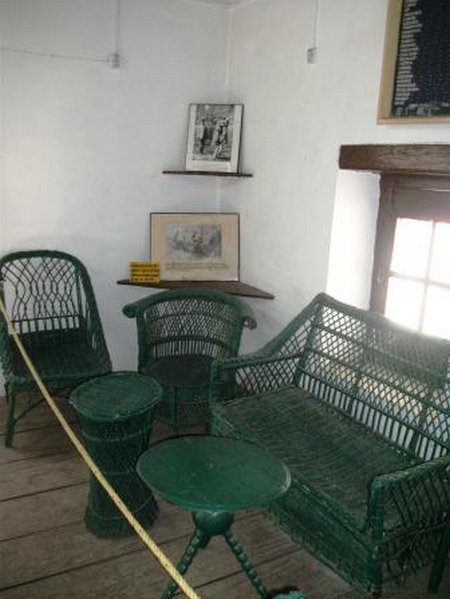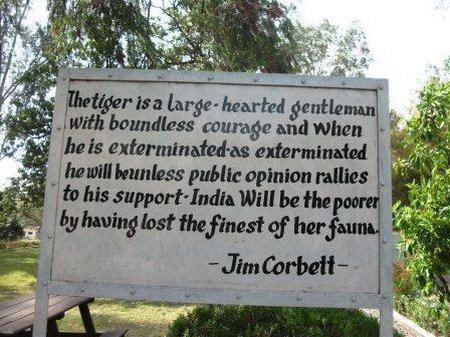Jim Corbett Museum, Once The Jim corbett’s Bungalow is situated at Kalaghugi-Foothills of Nainital district in Uttarakhand.

Jim Corbett’s Bungalow / Jim Corbett Museum in Kaladhungi
Table of Contents


Inside the Jim Corbett Bunglow


A Painting in the Jim Corbett Museum

Jim Corbett on Tigers in a painting at Jim Corbett Museum

Jim Corbett’s Bungalow in Kaladhungi, nestled in the foothills of the Nainital district in Uttarakhand, is a hidden gem that holds great historical significance. This picturesque bungalow, also known as the Corbett Museum, provides a fascinating glimpse into the life of the renowned British hunter and conservationist, Jim Corbett.
Introduction Jim Corbett’s Bungalow & Museum
Jim Corbett’s Bungalow, located in the serene town of Kaladhungi, was once the residence of the legendary Jim Corbett himself. The bungalow has been beautifully preserved and converted into a museum dedicated to his memory. It offers visitors a unique opportunity to delve into Corbett’s extraordinary life and his incredible contribution to wildlife conservation.
At Jim Corbett’s Bungalow, visitors are transported back in time to experience the rich history and legacy of this remarkable individual. The museum not only showcases Corbett’s personal belongings, photographs, and letters but also provides valuable insights into his adventures and conservation efforts. This immersive experience allows visitors to truly understand the impact he had on the region and the importance of preserving wildlife.
The Life and Legacy of Jim Corbett
Jim Corbett was not only an exceptional hunter but also a dedicated conservationist. Born in 1875 in Nainital, he spent his early years exploring the jungles of the Kumaon region. Over time, he developed a deep connection with the natural world and a passion for protecting the wildlife that inhabited the area.
Corbett’s notable achievements include hunting down man-eating tigers and leopards that posed a threat to the local communities. His bravery and skill in tracking and eliminating these dangerous animals earned him a legendary status among the locals. However, as he grew older, he realized the importance of preserving wildlife and decided to shift his focus towards conservation.
Corbett’s transformation from a hunter to a conservationist was a pivotal moment in his life. He recognized the need to balance human-wildlife conflicts and worked tirelessly to create awareness about the importance of conservation. His efforts led to the establishment of India’s first national park, which was later named after him as the Jim Corbett National Park. Today, it stands as a testament to his vision and commitment to wildlife preservation.
Exploring Jim Corbett’s Bungalow & Museum
Visiting Jim Corbett’s Bungalow is like stepping back in time. The Jim Corbett Museum showcases Corbett’s personal belongings, photographs, and letters, providing a glimpse into his eventful life. As you walk through the rooms, you can almost feel his presence and get a sense of the adventures he undertook to protect the people and wildlife of the region.
The museum also displays Corbett’s hunting weapons, including Jim Corbett rifle, which he used during his hunting expeditions. These artifacts offer a deeper understanding of the challenges he faced and the skills he possessed as a hunter.
Moreover, the museum offers interactive exhibits that engage visitors and provide a comprehensive understanding of Jim Corbett’s work. From informative displays on the flora and fauna of the region to audiovisual presentations on his conservation efforts, every aspect of the museum is designed to educate and inspire.
Highlights of the Jim Corbett Museum
- Library: The museum houses a well-stocked library that contains books written by Jim Corbett, providing visitors with an opportunity to delve into his writings. His books, such as “Man-Eaters of Kumaon” and “The Man-eating Leopard of Rudraprayag,” are renowned for their vivid storytelling and captivating accounts of his encounters with dangerous predators. These literary treasures allow visitors to gain deeper insights into Corbett’s experiences and his perspective on wildlife conservation.
- Photographs and Memorabilia: The museum proudly displays a vast collection of photographs capturing Jim Corbett’s expeditions and encounters with wildlife. These photographs depict the breathtaking landscapes and the majesty of the animals he encountered, allowing visitors to witness the beauty of the region through his lens. Additionally, the museum showcases various memorabilia, including personal items and awards, which further enhance the immersive experience and provide a glimpse into Corbett’s personal life.
- Nature Walks: Besides exploring the museum, visitors can also embark on nature walks in the surrounding area. These walks offer a chance to immerse oneself in the picturesque beauty of the Nainital district and experience the rich biodiversity that Jim Corbett was passionate about preserving. Guided by knowledgeable naturalists, visitors can learn about the flora and fauna of the region firsthand, gaining a deeper appreciation for the importance of conservation efforts.
- Insightful Exhibits: The museum features informative exhibits that shed light on the flora and fauna of the region. Visitors can learn about the various species found in the area and understand the importance of conservation efforts. From detailed dioramas showcasing the habitats of different animals to interactive displays explaining the ecological balance, these exhibits provide valuable knowledge and promote awareness about the need to protect our natural heritage.
In Summary, we have learnd in this blogpost; Jim Corbett’s Bungalow in Kaladhungi is a treasure trove of history, providing a fascinating insight into the life and work of this remarkable individual. From his thrilling hunting expeditions to his transformation into a conservationist, Corbett’s legacy continues to inspire and educate visitors from all over the world.
A visit to this museum is not only an opportunity to learn about the extraordinary life of Jim Corbett but also a chance to appreciate the breathtaking beauty of the Nainital district. The museum’s immersive exhibits, coupled with nature walks in the surrounding area, offer a holistic experience that appeals to nature lovers and history enthusiasts alike.
By exploring Jim Corbett’s Bungalow, visitors can gain a deeper understanding of the significance of wildlife conservation and the need to protect our natural heritage.
So, make sure to include Jim Corbett’s Bungalow in your itinerary when exploring Uttarakhand, as it promises an enriching experience that combines history, nature, and a profound appreciation for the remarkable legacy of Jim Corbett..
Frequently Asked Questions
Where is Jim Corbett’s Bungalow located?
Jim Corbett’s Bungalow is located in Kaladhungi, in the foothills of the Nainital district in Uttarakhand.
What can I expect to see at Jim Corbett’s Bungalow?
At Jim Corbett’s Bungalow, you can see personal belongings, photographs, and letters of Jim Corbett. The museum also displays his hunting weapons and offers interactive exhibits on the flora and fauna of the region.
What are the highlights of the Corbett Museum?
The highlights of the Corbett Museum include a well-stocked library with Jim Corbett’s books, a vast collection of photographs and memorabilia, nature walks in the surrounding area, and insightful exhibits on the region’s flora and fauna.
What is the significance of Jim Corbett’s legacy?
Jim Corbett’s legacy lies in his transformation from a hunter to a conservationist. His efforts led to the establishment of India’s first national park, the Jim Corbett National Park, and he played a crucial role in raising awareness about wildlife conservation.